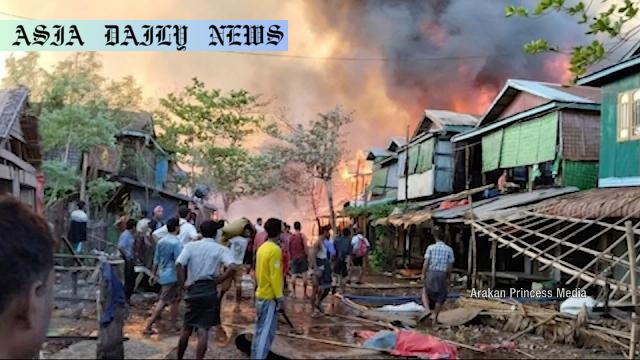China brokers a ceasefire between Myanmar’s military and the MNDAA amid ongoing conflict in the region.
Myanmar’s junta and the ethnic Kokang-based MNDAA agree to ceasefire.
China brokers the agreement to promote border stability and development.
The efficacy of the ceasefire remains uncertain amid ongoing conflicts.
Previous deals between the military and armed groups collapsed within months.

Introduction
Myanmar’s ongoing internal conflict reached another turning point as the country’s junta and the Myanmar National Democratic Alliance Army (MNDAA) entered into a ceasefire agreement. This accord, brokered by China, aims to de-escalate violence in northern Shan State and promote stability along the China-Myanmar border. Despite the agreement, concerns remain over its sustainability owing to the country’s broader conflicts with other armed ethnic groups.
Background of the Conflict
The MNDAA is an armed ethnic group primarily composed of the Kokang minority. Based in northern Shan State, the group has been engaged in hostilities with Myanmar’s military, especially in recent months. In October 2023, the MNDAA launched an offensive in collaboration with other ethnic armed factions, escalating violence in the region.
Myanmar’s political and security turmoil stems from a military coup on February 1, 2021, which ousted the democratically elected government. This event triggered widespread protests, leading to continued fighting between the junta and various armed insurgent groups. Despite efforts to negotiate peace and ceasefires, active hostilities have persisted throughout the years.
China’s Role in Brokering Peace
China has played a pivotal role as a mediator in Myanmar’s internal conflicts. The Chinese government views stability in Myanmar’s northern regions as essential to ensuring the security and economic prosperity of its own border areas. In January 2023, Beijing also brokered a ceasefire between Myanmar’s military and three ethnic armed groups, including the MNDAA. However, that truce collapsed after a few months, illustrating the fragility of such agreements in the region’s volatile context.
The recent ceasefire announcement comes as part of China’s renewed efforts to mediate and stabilize the situation. The agreement took effect on Saturday. During its announcement, Chinese Foreign Ministry Spokesperson Mao Ning underscored the significance of stability, stating that border security benefits all parties in Myanmar and neighboring nations.
The Challenges Ahead
Although the ceasefire between the junta and MNDAA is an encouraging development, its implementation faces several hurdles. Myanmar’s military continues to clash with other armed ethnic groups, and tensions remain high in regions beyond Shan State. Additionally, the junta’s reputation for reneging on agreements and the complex dynamics of ethnic insurgent alliances raise doubts about the truce’s longevity.
Earlier this month, Myanmar’s military conducted airstrikes in western parts of the country, resulting in the deaths of about 40 civilians. Such actions exemplify the broader conflict context in which this ceasefire exists, casting uncertainty on the prospects for nationwide peace.
Implications for the Region
The stability of northern Myanmar holds implications for broader regional dynamics. For China, a stable border ensures the safety of trade routes and prevents the potential spillover of violence into its territory. Furthermore, a prolonged conflict could disrupt China’s Belt and Road Initiative projects in Myanmar, impacting its strategic and economic interests.
Regionally, countries like Thailand and India, which border Myanmar, also face challenges related to the conflict, including increased refugee inflows and heightened security concerns. A sustained cessation of hostilities in Myanmar would offer some respite, albeit localized.
Conclusion
The ceasefire agreement between Myanmar’s junta and the ethnic Kokang-based MNDAA, brokered by China, provides a momentary respite in an otherwise turbulent conflict. While it underscores China’s strategic focus on stabilizing the region, the durability of the agreement remains in question. With ongoing violence in other regions of Myanmar and a history of short-lived truces, comprehensive peace continues to be elusive. The situation warrants close monitoring to gauge whether this latest effort will lead to meaningful progress or become yet another fleeting arrangement in Myanmar’s long history of internal strife.



Commentary
A Step Towards Peace Amid Uncertainty
The ceasefire agreement between Myanmar’s junta and the MNDAA can be commended as a step in the right direction. It not only reflects efforts by key players like China to bring stability to the region but also offers a glimmer of hope for those caught in the crossfire of Myanmar’s prolonged conflict. That said, skepticism remains, particularly given the history of failed ceasefires and the broader complexities of armed ethnic movements in Myanmar.
The Broader Implications
The involvement of China in brokering this deal exemplifies Beijing’s increasing role and influence in Myanmar’s internal affairs. As a powerful neighbor, China’s interests in stabilizing its borders and securing its economic investments are undeniable. Yet, such agreements often lack enforceability, as they depend on goodwill from the military junta—a body notorious for its inflexibility and aggression.
Furthermore, the agreement leaves key questions unanswered. Will other armed ethnic groups follow suit and pursue dialogue? What steps will the junta take to foster a more inclusive political process? Without addressing these deeper issues, such agreements risk being band-aid solutions to a much larger problem.
A Way Forward
Ultimately, resolving Myanmar’s internal conflicts will require more than ceasefires. A sustainable peace process necessitates inclusive political reforms, international pressure on the junta, and meaningful dialogue with all stakeholders, including pro-democracy groups and ethnic factions. While the current truce is a welcome development, it must be seen as just one step in a far longer journey toward peace and reconciliation in Myanmar.